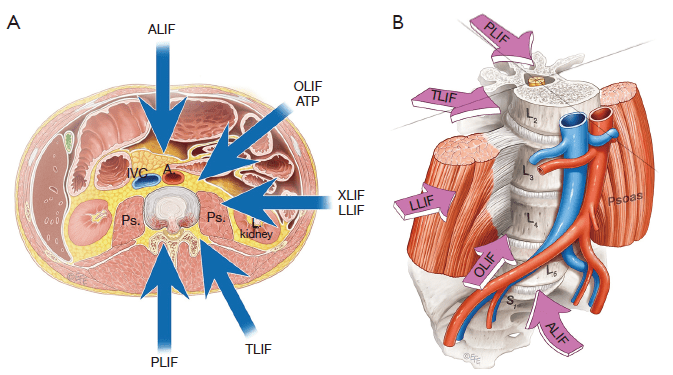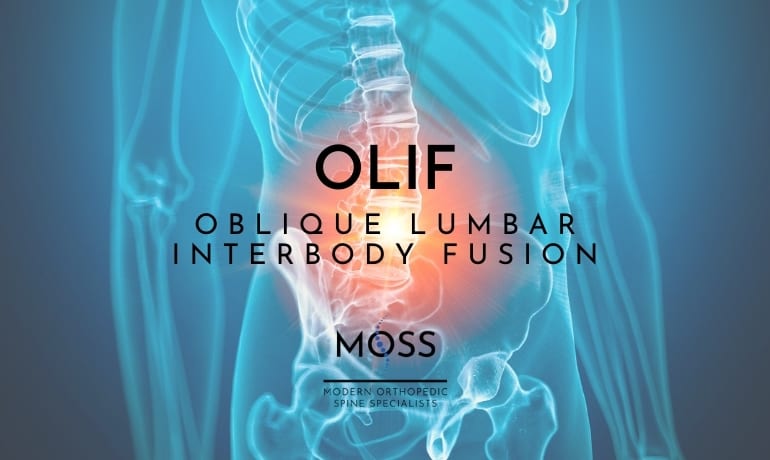OLIF vs. DLIF (aka XLIF) vs. ALIF- What’s the Difference?
OLIF/ALIF/XLIF surgeries correct problems caused by a degenerative disc in your spine and create more space for your nerves. The surgeon removes the damaged intervertebral disc and replaces it with an interbody cage, fusing two adjacent spinal vertebrae and restoring disc height.
ALIF, or Anterior Lumbar Interbody Fusion, involves approaching the spine from the front (anterior) of the body.
DLIF (aka XLIF) or Direct Lateral Lumbar Interbody Fusion, involves approaching the spine from a direct lateral(side) of the body.
OLIF, or Oblique Lumbar Interbody Fusion, is a less invasive approach to spinal fusion surgery. With OLIF, the surgeon accesses and repairs the lower (lumbar) spine from an area between the front and side of the body. This allows for a less-invasive approach, since there is no trauma to the psoas muscle – the muscle that connects the lower back to the thighs. With OLIF there is also no need to mobilize the major vasculature as in the ALIF procedure.

In the image above, Figure A shows an aerial perspective of the spine, and Figure B shows it from the side. Each of the arrows indicate the direction from which the surgeon enters the body for the procedure.
Risks of ALIF Surgery
During ALIF surgery, the mobilization of the major blood vessels can have serious complications and risk vascular injury. This is due to the exposure and mobilization of the aorta and vena cava. This can carry risks of both vascular and non-vascular complications.1 Many patients who require ALIF surgery could also be a candidate for OLIF surgery.
Risks of DLIF (XLIF) Surgery
During DLIF surgery, a large muscle known as the psoas is split apart in order to access the disc space. Within the psoas muscle traverse most of the major nerves known as the Lumbar Plexus. The retraction of these nerves could potentially cause neurologic deficits/weakness of the muscles of the thigh and leg. More information on post-surgical weakness associated with XLIF surgeries can be found here.
Benefits of OLIF Surgery
You can achieve the same fusion results and back pain relief with OLIF as you can with ALIF or DLIF, but with OLIF you’ll face fewer potential complications and enjoy several benefits. Because OLIF surgery is minimally invasive, there is no need to mobilize the vessels or penetrate the psoas muscle, you can expect the following benefits:
- minimal blood loss
- shorter hospital stay
- faster recovery time
- lower risk of infection
- decreased chance of lower extremity weakness
What Happens During OLIF Surgery?
During an OLIF procedure, the surgeon uses a corridor between the psoas muscle and the great vessels to access the disc space. This means movement and flexibility of the back, pelvis, legs, and hips is not jeopardized by traumatizing the psoas muscle. While OLIF is considered a minimally invasive procedure, it is not performed endoscopically. Please refer to our blog about Endoscopy for more information.
That’s why the OLIF procedure was developed – to prevent the need to split the psoas muscle and prevent injury to the embedded nerve roots.
To give you some background, the psoas muscles are pretty important to everyday life. They attach from your 12th thoracic vertebrae to your 5th lumbar vertebrae, through your pelvis, and then finally down to your femurs.
Your psoas muscles allow you to bend your hips and legs toward your chest, for example, when you are going up stairs. They also help to move your leg forward when you walk or run. These same muscles flex your trunk forward when you bend over to pick up something from the floor. They also stabilize your trunk and spine during movement and sitting.
In fact, sparing the Psoas muscles in surgery spares you the following long-term troubles in everyday life:
- Weakness of hip flexors
- Muscle weakness
- Decreased mobility
- Leg numbness
- Longer recovery from surgery
What is The Recovery Time for Lumbar Fusion Surgery?
Recovery time varies from patient to patient, but many return to physically demanding work around 8-10 weeks and sooner for individuals who have a desk job. Modern Orthopedic Spine Specialists treat the following conditions of the lumbar spine using OLIF Surgery:
- Degenerative disc disease
- Repeated Disc Herniations (when disc slips and ruptures into spinal canal)
- Spondylolisthesis (when vertebrae slips forward)
- Spinal deformities, such as scoliosis or kyphosis
- Intractable back pain that has failed non operative management
For more information on this surgery, please visit our Education Page
contact Modern Orthopedic Spine Specialists at 805-370-0748, or email us at info@themodernspine.com.
You can also visit our office at:
250 Lombard Street
Thousand Oaks, CA 91360

